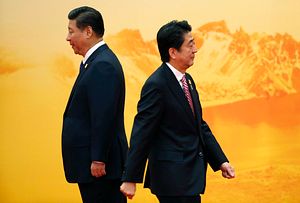What is the most worrying relationship in Asia today? Where is there the greatest potential for the most destructive conflict? Would it be from North Korea, with its burgeoning and almost incessant nuclearization program, perhaps, or the ongoing tensions between Pakistan and India? Is a more urgent issue China’s ongoing clashes with the other competing parties in the South China Sea and the potential that this might lead to direct conflict with the United States? Or the real possibility of instability and fragmentation in, for instance, a young democracy like Indonesia, with its internal complexity and lack of institutional strength?
All of these are worrying problems. But if we look at history, the longest standing tensions — the area most strewn with competing, and frankly incompatible, visions for the region –is found in the relationship between China and Japan. It is this relationship that poses the most worrying problems for the future.
Though it is obviously a very complex issue, we can boil the Sino-Japanese conundrum the world and the Asian region have to sort out down to one simple question: in view of their inability to harmoniously exist side by side for the last millennia or so, can we really see ways in which a strong China and a strong Japan manage to exist alongside each other without conflict in the 21st century? If they do achieve this, they will be going against the pattern of their whole history with each other.
And what a terrifying history this has been. As American scholar June Teufel Dreyer shows in Middle Kingdom and Empire of the Rising Sun, a book just published by Oxford University Press, the fight for regional dominance stretches back 1,500 years. Japanese and Chinese imperial disdain for each other manifested itself very early on in prickly protocol, with the Chinese dynastic courts always trying to present Japan as a semi-vassal state, and the Japanese returning the contempt in the earliest dynasties. The documents Dreyer uses in her overview of the first thousand years of this history give ample testimony to this phenomenon. But the real clashes occurred when Japan undertook its rapid, and impressive, modernization in the late 19th century. Its victory in war not just with Qing China in 1895, but against the Russians in 1905, were preludes to a rampant nationalism that engulfed the whole region during World War II.
A long term view of this history shows a clear pattern: fractious troughs followed by warm peaks, before the troughs reoccur again. There were warm moments in the 1970s and into the 1980s, with the odd, short sunny period in the 1990s and mid-2000s. But the recent dip in relations has been a long one, continuing for almost a decade. Such dips and peaks are connected by an internal logic – they are evidence of strategic competition between the two. But the recent downturn occurs in a context in which, for the first time ever, both are modernized, globally significant economies. The risks arising from their inability to create long term, balanced, sustainable relations with each other have therefore escalated.
We know one of the main sources of this recent ill feeling on the Chinese side – the continuing anger over what is seen as Japanese unwillingness to confront their history of aggression in World War II. For Japan, where the vast majority of its people were born long after the tragic events of eight decades ago, however, this persistence by China for greater, continuing penance has clearly started to grate. Japanese irritation toward the Chinese is more recent, and stems from the ways in which former prime ministers from the early 1970s onward into the 1980s made a clear strategic decision to engage and work with China in its modernization process but received a poor return for it. Dreyer quotes one staggering statistic in her book that illustrates this – 70 percent of Japanese aid went to China in the 1980s. But the relationship was about more than mere money; Japan was a major technology and knowledge partner. Chinese reform and opening up would not have succeeded as quickly, and as extensively, without this assistance.
In Japan, the consensus has been growing that the whole gamble of engagement with China is starting to look like it was a mistake. Their neighbor has not changed politically, nor has it developed grateful or friendly feelings toward Japan. On the contrary, it has come increasingly to look like Japan’s worst nightmare – a strong, Communist led one party state, angry and harboring revengeful sentiments toward Tokyo. Most worrying of all, China is now building up naval military assets that look increasingly like they are pointed directly at Japan’s interests.
The ancient Greek historian Thucydides showed long ago that the price for peace is perpetual preparation for war. Complacency about China and Japan being able to just muddle along and never clash with each other again would run against the long history where these clashes and fights happened all too often – with disastrous results for the region, and the two countries themselves. Those that blithely counsel the United States to simply withdraw from Asia have to give reassurances that in the vacuum Japan and China won’t immediately fall directly on each other. Such reassurances are impossible to give. As Dreyer’s book shows, the history of Sino-Japanese relations has proved a terrible and bloody one. Creating a sustainable framework in which, at the very least, they can both manage their problems toward each other without resorting to fighting is the single greatest challenge, and the source of the most worrying instability, in Asia today.

































